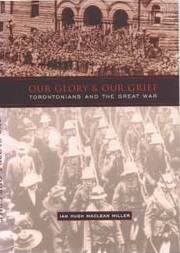 This information has been archived for reference or research purposes.
This information has been archived for reference or research purposes.
Archived Content
Information identified as archived on the Web is for reference, research or recordkeeping purposes. It has not been altered or updated after the date of archiving. Web pages that are archived on the Web are not subject to the Government of Canada Web Standards. As per the Communications Policy of the Government of Canada, you can request alternate formats on the "Contact Us" page.
BOOK REVIEWS
OUR GLORY AND OUR GRIEF: TORONTONIANS AND THE GREAT WAR
by Ian H.M. Miller
Toronto: University of Toronto Press 2002, 264 pages, $45.00
Reviewed by Major Andrew B. Godefroy
For more information on accessing this file, please visit our help page.

The subject of Canada and the First World War continues to receive attention from scholars, with a modest yet steady flow of new literature available on an increasingly regular basis. More important, perhaps, is that while social and biographical memoirs continue to dominate the field, more Canadian historians are conducting complex analyses of the war. Ian Miller’s recent book, Our Glory and Our Grief: Torontonians and the Great War, is an interdisciplinary examination that offers more than just a social history. Rather, it attempts to reveal the anatomy of one of Canada’s largest population centres during the first major conflict of the 20th century.
From the outset Miller is intent on reshaping conventional views about Canada and the Great War. Unsatisfied with the stereotypical descriptions often found in contemporary works, his thesis paints a dramatically opposite impression of the war’s impact on the lives of Canadians at home. While acknowledging the current body of work that analyzes the memory and meaning of the Great War, Miller quickly departs from this group, explaining that he intends to shed greater light on the “comparatively little attention [that] has been devoted to the impact of the war on the lives of citizens as it was happening.” Miller takes issue with prior analyses by historians such as Jeffrey Keshen, author of Propaganda and Censorship During Canada’s Great War (1996), who suggested that Canadians at home were largely uninformed and manipulated participants. He offers the opposite view: that the home front was well attuned to the realities of the war and still, “people were willing to fight for God, King, and Country”.
Delving into his case study of Toronto, Miller draws largely from the newspapers of the period. This by no means indicates poor research, but rather highlights the good use of the most plentiful primary source of information about the city during that period. Further, an examination of daily events adds to the detail presented throughout the book and the feeling of what it was like to be there at that time. The reader quickly learns that not only were Torontonians well informed about the international relations surrounding the War, they were fully prepared to support Britain in its cause right through to the end of the conflict. The papers of Toronto record a consistently high degree of volunteerism even after the horrors of Second Ypres, the Somme and Passchendaele appeared on the front pages. Almost all eligible men in Toronto had volunteered for service prior to the implementation of conscription, and after its announcement men continued to step forward prior to their forced enlistment.
While the book is an excellent study, it does fall short of what the title promises. Of the six chapters, five are devoted largely to enlistment, recruitment and conscription. The chapter that addresses a different topic – Women and War: Public and Private Spheres – is perhaps the best chapter in the book for its revelations about private and public life in wartime Toronto. There is little or no discussion of politics other than that related to recruitment, and little offered about the economy, city infrastructure, industry, urban development or other related urban studies. Essentially, one is left feeling that the opportunity to explore the many facets of the city was missed.
Though there are already books that examine Canada’s enlistment and conscription issues during the Great War, they do so only at the national level. Ian Miller’s case study of Toronto allows one to dig down deeper, and offers very different conclusions than one might expect. Though not all-encompassing, this book breaks new ground in the study of Canada and the Great War and deserves to be recommended.
Major Andrew Godefroy is commander of the Canadian Forces Joint Space Team. He is completing his doctorate in War Studies at Royal Military College.






